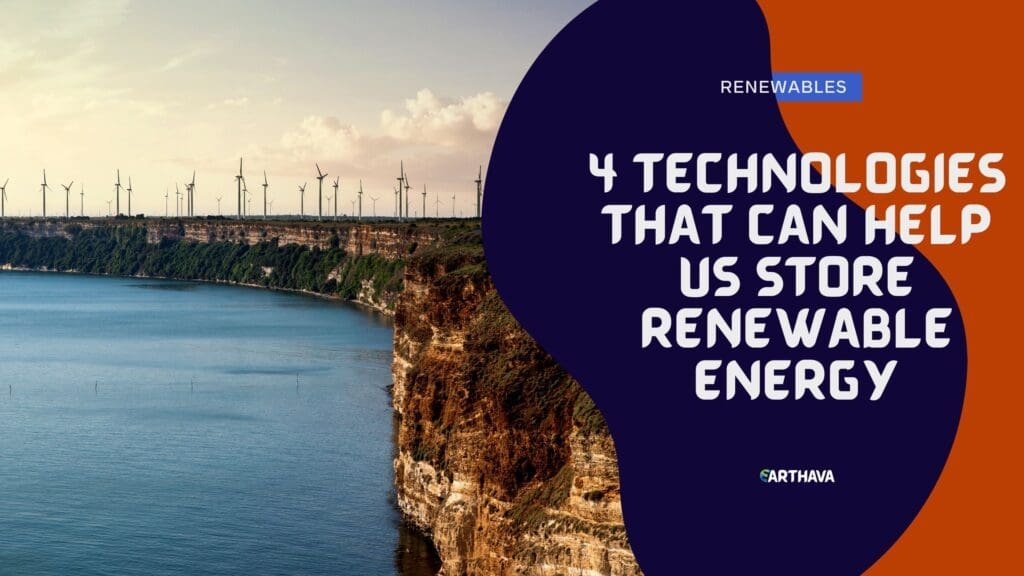Renewable energy is the future, and it’s important to make sure that it’s used to its fullest potential. But what can be done when there’s not enough sun or wind? Luckily, a few innovative technologies can help store renewable energy and make energy storage simpler. This post discusses three of four technologies.

1. Batteries
Batteries are a type of renewable energy storage that works by converting chemical potentials into electrical potential. They do this by transferring electrons from the anode to the cathode, generating electricity, and moving ions between both electrodes in the process.
Batteries can be used for portable power but have historically been too large or costly to be practical on grid-scale projects. However, recent advances, like using lithium and other metals such as nickel and cobalt, have made them more economical. Lithium-ion batteries (LIB) are made up of relatively inexpensive materials, making them highly desirable over lead-acid batteries that require heavy metal components such as antimony and mercury.
Nickel-cadmium (NiCd) or nickel-metal-hydride (NiMH) may also work well in some cases because of their low cost. Plus, their cells can come close to 100% round trip efficiency, meaning that almost all electricity will end up stored on their battery pack during discharge with no degradation at all from losses incurred during charging cycles.
2. Pumped Hydroelectric Storage
Pumped hydroelectric storage is a technique used to store electricity in the form of potential energy. It uses two reservoirs at different elevations connected by pipes or tunnels that can hold water and compressed air. The lower reservoir holds water, while the upper reservoir stores high-pressure air above it. When there is an excess power supply on the grid, pumps move the liquid back up to repeat this cycle as many times as necessary until demand subsides again.
Pumped hydro plants typically have both temporary and permanent installations for storing surplus power before they’re deployed where needed. They’re often installed where geological features such as natural hills provide elevation and water sources. In addition, they are often used with hydroelectric dams, which generate large quantities of power because they can store and release water as needed.
These pumps also have a long lifespan, in part because some installations use concrete or other materials for the construction of reservoirs. They’re also equipped with safety features such as shutoff valves to prevent damage from disasters.
3. Liquid Air Energy Storage
Liquid air energy storage (LAES) has been proposed as a means to store energy produced by wind turbines or solar panels. In the process, the air is compressed into tanks and cooled until it becomes liquid air at low pressure. The stored liquid can then be heated back up to atmospheric pressure to generate power. In addition, the stored liquid air can be used to provide cooling during the summer or be injected into natural gas pipelines for conversion into synthesis gas.
A key advantage of this technology is that it does not require any additional infrastructure and typically requires only a small amount of farmland for storage tanks. The main disadvantages are its high cost (about twice as much per watt-hour) and low round-trip efficiency.
A trial conducted in Sweden revealed that LAES could provide an alternative way for storing electricity for long periods when demand exceeds supply on the grid during winter peaks or drought conditions where there’s limited access to hydropower sources.
4. Flywheels
A flywheel is a mechanical device that stores rotational energy. They can be used to store kinetic energy, which dissipates as heat and sound once the object stops rotating. Flywheels are made of steel or aluminum and have high inertia due to their mass and high-speed spins. This allows them to provide long periods of power output without external input other than gravity.
There are two types of flywheels: disk-type and tubular-type. The disk type uses natural angular momentum while tubular designs rely on internal friction to keep them spinning continuously. This technology is being tested for several uses in the renewable energy storage industry, including battery storage. They can be used to store electricity generated from solar panels and wind turbines when there is an excess.
Additionally, flywheels have been proposed for use in hybrid automobiles because they offer extended periods of operation without any need for refueling or recharging. These vehicles will run on batteries until they have reached their charge limit before a small internal combustion engine automatically kicks into gear and recharges them with gasoline while still providing some level of propulsion.
The Bottom Line
The future of renewable energy storage will rely on innovative storage technologies. These are some great options for storing power and keeping the supply going when they’re needed most. Investing in these technologies is a good idea because it’ll ensure everyone has access to clean, sustainable energy. It will also be more readily available for use in low-carbon economies of the future.


